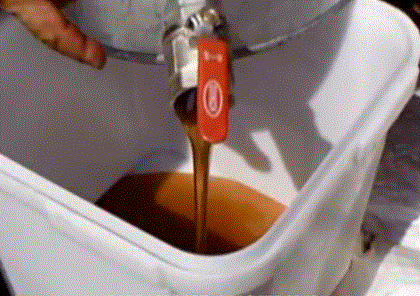Chestnut honey - excellent honey of the Mediterranean coast
Bees collect honey from the flowers of the sweet chestnut or common chestnut, as well as horse chestnut. These honey plants are completely different and their honey is also completely different. Chestnut honey from horse chestnut is light, almost colorless. Chestnut honey from sweet chestnut is completely different - dark, fragrant, does not crystallize for a long time. It is chestnut honey from sweet chestnut flowers that is the visiting card of the Mediterranean and Black Sea coasts. In this article, we will look at what real chestnut honey looks like, chestnut honey benefits and harms, what are the features of chestnut honey, what are the healing properties of chestnut honey and many other interesting facts about honey that will be of interest to consumers.
.
Content
- 1 Features of chestnut honey
- 1.0 Chestnut honey where bees collect it
- 1.1 What chestnut honey looks like
- 1.2 Chestnut honey color
- 1.3 Aroma of chestnut honey
- 1.4 Taste of chestnut honey
- 1.5 Composition of chestnut honey
- 1.6 Crystallization of chestnut honey
- 1.7 Calorie chestnut honey
- 1.7.1 Glycemic index of chestnut honey
- 1.7.2 Chestnut honey in cooking
- 1.8 When chestnut honey is harvested
- 2 Chestnut honey useful properties and contraindications
- 2.0 Useful properties of chestnut honey
- 2.1 Source of vitamins and antioxidants
- 2.2 Antibacterial properties of chestnut honey
- 2.3 For hypertension
- 3 Medicinal properties of chestnut honey
- 3.1 Chestnut honey for children
- 4.1 Is chestnut honey possible during pregnancy - chestnut honey for women
- 4.2 Chestnut honey benefits for men
- 5 Contraindications to the use of chestnut honey
- 6 The use of chestnut honey in cosmetology
- 7 How to choose chestnut honey - how to distinguish natural chestnut honey from a fake
- 7.1 Appearance
- 7.2 Using improvised means
- 8 Chestnut or flower honey
Features of chestnut honey

Chestnut honey where bees collect it
Chestnut honey is not inferior in quality to linden honey, buckwheat honey, angelica honey, heather honey, coriander honey, Melilot honey, clover honey, Cotton honey, Lavender honey and other excellent varieties of flower honey. Chestnut honey where bees collect it and from what. Bees collect chestnut honey from the flowers of the sweet chestnut or the sowing chestnut. Chestnut is an sweet tree, whose birthplace is the Mediterranean, sowing chestnut grows in sufficient quantities only in the Caucasus, so chestnut honey can only be from the subtropics of the Caucasus, and even then it is not enough. Large quantities of chestnut honey are collected in the countries of the Balkan Peninsula (Turkey, Greece, Bulgaria, Croatia), and chestnut honey can also be collected in some regions in Spain and Italy. So chestnut honey where bees collect it. Chestnut honey is collected in the apiaries of the Krasnodar Territory and Adygea, especially in the Sochi region, where mountain chestnut honey is collected. chestnut honey is also harvested in Abkhazia, where Abkhazian chestnut honey is obtained. Outside the territory of Russia, chestnut honey is harvested in Georgia, in other countries of the Caucasus, as well as in Turkey and the Mediterranean region, especially in Italy, France, chestnut honey from Corsica and Spain is especially famous. Chestnut honey is popular in Italy, France, Turkey and other Mediterranean countries where there are forests with sweet chestnuts. The fruits of the sowing chestnut are eaten in many countries.
Chestnut honey is often blended with other types of honey. Chestnut honey is often used by the confectionery industry. Chestnut honey is suitable for wintering bees as it does not crystallize for a long time.
What are the benefits of chestnut honey? What are its beneficial properties? Much can be said about the benefits of chestnut honey for the human body.
What does chestnut honey look like?
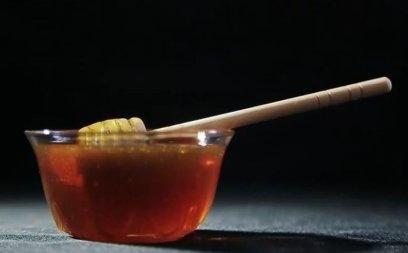
Therefore, it is worth considering in more detail chestnut honey from sweet chestnut, what color, taste, aroma and texture it has, how quickly it crystallizes.
Let's also pay attention to what chestnut honey looks like, collected by bees from horse chestnut flowers. Both honeys are considered chestnut, but they are completely different.
chestnut honey color
Chestnut honey its color from sweet chestnut is considered a dark variety of flower honey. The color of chestnut honey is dark, the color palette can vary from light brown when pumping honey to dark brown when the honey settles. Horse chestnut honey has a light color, on the contrary, this kind of honey is almost transparent.
Aroma of chestnut honey
Chestnut honey from the Krasnodar Territory can be recognized by its smell, this honey has a pleasant aroma of sweet chestnut flowers, there may be an aroma of roasted coffee and caramel.
Taste of chestnut honey
The taste of chestnut honey from sweet chestnut has a very original specific aftertaste, due to a slight bitterness in it. At the same time, it is a very tasty honey. With a little heating, the taste of chestnut honey becomes quite pleasant to the taste and loses its bitterness. It is difficult to describe the taste of chestnut honey from horse chestnut, it is all consumed by bees for feeding the brood.
Composition of chestnut honey
Chestnut honey has a large set of trace elements, vitamins and amino acids.
The fructose/glucose (F/G) ratio in chestnut honey ranges from 1.4 to 1.5. This ratio is the result of changing climatic conditions during the period. The third sugar found in the largest amount is the disaccharide sucrose, with an average content of 2%, which is relatively low. The amount of sucrose in chestnut honey varies depending on the degree of maturity and composition of the nectar. Chestnut honey also contains longer chain forms of saccharides called oligosaccharides, which are classified as prebiotics, regulating the balance of intestinal microflora by stimulating the growth of beneficial lactic acid bacteria, incl. such as: Streptococcus thermophilus, Lactobacillus acidophilus, Lactobacillus delbruecki and/or Bifidobacterium bifidum.
Chestnut honey differs from other honeys in relatively low acidity (average 20 mval/kg), which is confirmed by higher pH values (average 5.31). Depending on the organic acids present in honey, the pH ranges from 3.5 to 5.5. Chestnut honey is known for its antioxidant and antibacterial properties, which is due to the composition of honey and, in particular, the high concentration of flavonoids (such as apigenin, chrysin, pinocembrin) or organic acids (cinnamic acid derivatives - caffeic acid). and kynurenic acid) and active enzymes present in honey.
The composition of chestnut honey is characterized by the following indicators:
the mass fraction of water in it is at the level of 17-18%,
mass fraction of reducing sugars 69%,
mass fraction of sucrose 3.2%,
diastase number 10.5 Gothe units,
free acidity 14.8 meq/kg.
Crystallization of chestnut honey
Chestnut honey from the sweet chestnut crystallizes very slowly, after standing, honey becomes viscous and remains liquid all winter and only in spring turns into a dark amber mass.
Chestnut honey from horse chestnut, on the contrary, crystallizes extremely quickly.
Calories in chestnut honey
Chestnut honey is often included in diets and is used in the preparation of many culinary dishes, so many are interested in what is the calorie content of chestnut honey, how many kilocalories a person will receive with honey.
The calorie content of chestnut honey is 309 kilocalories per 100 g of products.
Glycemic index of chestnut honey
For many people, it is important to know what the glycemic index of chestnut honey is in order to make a diet. The glycemic index of chestnut honey is 70. This is a fairly high value. higher only in buckwheat honey and sunflower honey. In any case, 1 teaspoon of honey in the morning will not hurt much.
Glycemic index of honey
Chestnut honey in cooking
The taste of chestnut honey is combined with many dishes, so chestnut honey is one of the most widely used types of honey in cooking. It allows you to add flavor to some confectionery products, such as cookies, especially gingerbread, cakes and pies. Those who don't really like the taste of sugar use it in drinks like tea and coffee. Others add it to salads or spread it on bread. In the kitchen, the rich taste of chestnut honey goes well with cheeses and marinades. It can be used to prepare meat dishes.
When is chestnut honey harvested?
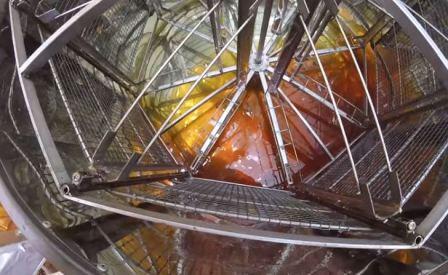
Chestnut honey is pumped out immediately after the flowering of the sweet chestnut, as a rule, this happens in the middle and end of July, depending on the weather and the location of the apiary, in height from sea level. Since the difference between the flowering of chestnut in the valleys and in the mountain forests is approximately 2 weeks. Chestnut honey is pumped out immediately after the end of the flowering of chestnuts, also because linden immediately begins to bloom, and if you do not pump out the honey immediately, you will get chestnut-linden honey. But we will talk about this a little later in more detail.
sweet chestnut blossoms after the leaves bloom in low places and in light forests in mid-June, in the mountains in early July, the chestnut blooms for two weeks.
As a rule, chestnut honey is not pumped out from horse chestnut, because honey collection takes place in May - early June, when bee colonies are developing and the bees eat almost all of it themselves.
Chestnut honey useful properties and contraindications
Useful properties of chestnut honey
What are the benefits of chestnut honey? Chestnut honey useful properties and its features are fully determined by the fact that almost all parts of the sweet chestnut plant are used in medicine. Chestnut honey is a source of vitamins and antioxidants and has high antibacterial properties.
Chestnut honey as a source of vitamins and antioxidants
The chestnut flowers are heavily visited by bees collecting nectar and pollen.
sweet chestnut emit a huge amount of pollen that bees willingly collect and add to honey.
Therefore, chestnut honey contains a large amount of macro and microelements: iron, copper, manganese, potassium, calcium, magnesium and others.
Chestnut honey contains a lot of pollen and is rich in vitamins, especially B6 and PP.
Therefore, chestnut honey is more valuable than ordinary varieties of light honey.
Antibacterial properties of chestnut honey
Chestnut honey has pronounced bactericidal and antiseptic properties. According to its bactericidal properties, chestnut honey collected by bees from sweet chestnut flowers is on the same level with buckwheat, heather and linden varieties of flower honey. Chestnut honey is significantly superior to other light-colored flower honey varieties in the fight against bacteria.
Chestnut honey for hypertension
Chestnut honey significantly improves the functioning of the circulatory system, the walls of blood vessels become stronger, more elastic, improves blood composition. Chestnut honey is especially recommended for hypertensive patients, with regular use of honey, they note normalization of pressure and improvement in well-being.
Medicinal properties of chestnut honey
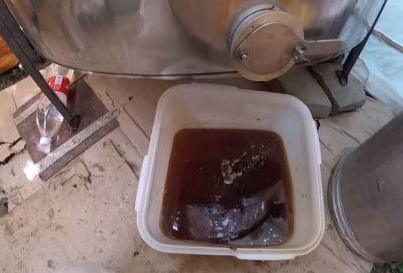
All parts of the chestnut have medicinal properties. Fat isolated from nuts is used in medicine. From the extract of the leaves, medicines are used for catarrh of the throat, vitamin K is obtained from the leaves, and medicines for indigestion are prepared from the roots of the chestnut.
The healing properties of chestnut honey are unique.
Chestnut honey has pronounced bactericidal properties, some tend to compare the effect of chestnut honey on the human body with the effects of a powerful natural antibiotic.
Why chestnut honey is useful in the treatment of diseases, chestnut honey is used in the treatment of:
- Chestnut honey has beneficial properties in respiratory diseases. Chestnut honey is high in antioxidants and contains many nutrients with anti-inflammatory and antibacterial properties. Thus, chestnut honey is very useful in treating respiratory problems, from colds to sinusitis, including bronchitis or flu. In addition, chestnut honey helps thin secretions, relieve nasal congestion and relieve coughs.
Chestnut honey exhibits beneficial properties in the treatment of cuts, minor burns, abrasions, - Chestnut honey has beneficial properties in the treatment of ulcers. Chestnut honey has been successfully used in the treatment of gastrointestinal ulcers without surgical intervention, as clinical trials show.
- Chestnut honey has the ability to increase appetite. Older people and children often suffer from digestive problems, especially if they do not follow a healthy and varied diet. Chestnut honey acts against these ailments and normalizes digestion, improving the function of the gastrointestinal tract, due to its mild laxative effect. In addition, it promotes the activity of the intestinal flora and fights micro-organisms that often cause digestive imbalances and can cause indigestion or other more serious problems.
- It is recommended to take chestnut honey with congestion in the liver, honey stimulates the liver and gallbladder.
- Chestnut honey takes on the properties of the plant from which it was obtained and is a real help for people suffering from circulatory disorders. It acts on veins and blood vessels.
Chestnut honey strengthens capillary walls and normalizes blood flow. - When using chestnut honey, its benefits are to increase efficiency, increase vitality.
- It is believed that almost all human inflammatory diseases can be cured by the use of chestnut honey in the human diet.
- Chestnut honey benefits the body in strengthening the immune system and increase the body's resistance to disease. Chestnut honey, being a natural source of vitamins and antioxidants, helps to increase the body's immunity. It helps to protect us from colds, flu or infections and helps us to have a strong and healthy body at any time of the year. Therefore, chestnut honey is especially indicated for children with a weakened immune system or elderly people with weak immunity.
- Chestnut honey benefits for the nervous system. The hectic pace of everyday life makes us constantly anxious, nervous, tired and sometimes makes us feel overwhelmed. Chestnut honey helps us in these difficult situations, having a beneficial effect on the nervous system. Helps relieve fatigue and stress, has a calming effect. Therefore, it is recommended for people who are very excited, nervous. Chestnut honey can act as a dietary supplement in some cases of depression.
- for the treatment of anemia. Due to the high content of minerals (copper, iron, manganese), chestnut honey is highly recommended for people with anemia. Easily digestible, does not irritate the digestive system and is quickly absorbed by the body. Chestnut honey brings vivacity, health and good mood to the body.
Chestnut honey helps fight heart disease. Consuming chestnut honey every morning will go a long way in maintaining cardiovascular health. Chestnut honey, which reduces the risk of heart attack, also balances the heart rate. - Chestnut honey beneficial properties are especially important for the circulatory system, honey is recommended for the treatment of cardiovascular diseases, honey is used to treat thrombophlebitis, as well as varicose veins, since honey regulates venous and arterial circulation.
- Some other chestnut honey properties to consider. Chestnut honey is known to be useful not only for throat infections, but also for urinary tract infections.
Natural chestnut honey, when consumed, can slow down cell aging. The composition of chestnut honey contains a large amount of antioxidants, phenolic compounds, flavonoids, tannin, which protect cells from the harmful effects of free radicals and therefore chestnut honey's beneficial properties and its features can be fully manifested if regularly used take honey after treatment with chemical drugs. Honey will help remove the side effects of medications.
Chestnut honey for children
An adult can quite easily take up to 100 grams of chestnut honey per day. Children under 1 year old are not recommended to give honey to avoid allergies, children under 12 years old should not be given more than one or two tablespoons of honey per day. Chestnut honey is given to children to improve appetite, during seasonal infections to strengthen immunity. Chestnut honey for children is suitable for great mental and physical stress.
Chestnut honey for women - Is it possible to use chestnut honey during pregnancy
How useful is chestnut honey for women? What is useful chestnut honey for women. Nursing mothers consume chestnut honey to get more milk.
Can women use chestnut honey during pregnancy. Chestnut honey is useful for pregnant women if there are no contraindications from doctors and subject to a certain measure of consumption. So chestnut honey for women is very useful.
Chestnut honey beneficial properties for men
Chestnut honey beneficial properties for men primarily lie in the ability to treat infections of the genitourinary system. Chestnut honey is useful for men who lead an active lifestyle and athletes, due to its composition, honey helps to increase efficiency and endurance. Chestnut honey is also useful for men who are in a stressful situation at work as an antidepressant and as a means of increasing the resistance of the nervous system to stimuli. Chestnut honey is good for men who have liver problems.
Contraindications to the use of chestnut honey
Is chestnut honey harmful to the human body? There are no contraindications for taking honey, except for intolerance or allergy to honey. Diabetics should consult a doctor before taking chestnut honey.
It is not recommended to take chestnut honey for people with blood diseases.
The use of chestnut honey in cosmetology
Chestnut honey may well be used in cosmetology, hair beauty, face and skin care, and weight loss. However, beauties should be prepared for the fact that beauty will be expensive financially, because real chestnut honey is very expensive.
How to choose chestnut honey - how to distinguish natural chestnut honey from a fake
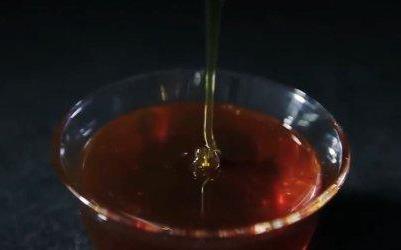
Chestnut honey is a very rare variety of honey for Russia, chestnut honey can only be obtained in a limited number of regions of the Krasnodar Territory and Adygea, chestnut honey from Abkhazia can also be present on the Russian market. Abkhaz chestnut honey is no worse than chestnut honey from the apiaries of the Krasnodar Territory. Therefore, first of all, pay attention to the region where chestnut honey comes from. Chestnut honey in no case can be from the central regions of Russia, the Urals, Siberia, Altai and so on. Secondly, pay attention to the price, getting chestnut honey is very expensive, because even the local beekeeper has to wander. Not to mention the fact that an apiary from another region will have to make a serious journey, both to the Krasnodar Territory, and then to the mountains to the chestnut forests.
It must also be remembered that the interval between the flowering of chestnut and linden is very small. Therefore, in order to get pure honey, some beekeepers pump out honey even before it has time to ripen, unripe honey is not good honey. In addition, some beekeepers, in order to obtain monofloral honey from sweet chestnut, dry it on special equipment. Such honey is very good and we can say that it is good chestnut honey. It does not matter chestnut honey from Abkhazia or the Krasnodar Territory.
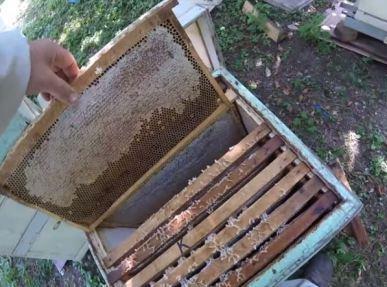
Conscientious beekeepers, as a rule, wait until the bees seal 2/3 of the comb with caps, this is already a sign that the honey is ripe. In addition, you can use store extensions, which the bees print very quickly. Also conscientious beekeepers often sell chestnut lime honey. Such honey is ripe and has a wonderful taste and aroma, which has incorporated the advantages of two excellent honey plants - sweet chestnut and Caucasian linden, some consider it even better than pure chestnut honey.
How to distinguish natural chestnut honey from a fake in appearance
When buying chestnut honey, pay attention to the naturalness of this honey in general.
- See how this honey flows from a spoon, is there a characteristic slide, if it is not there, then most likely the honey is either not real at all, or immature,
- Look at the spring-loaded drop from the spoon or not. A drop of honey flows like water or not. Real honey - each drop seems to be spring-loaded, pulled up and only after that it drips down.
- See how a trickle of honey flows down, even a thin trickle should not be interrupted, if it is interrupted, and chestnut honey remains liquid until spring, then the honey is not natural.
- The taste of chestnut honey is original and differs from the taste of ordinary honey, it gives off bitterness, but in no case should there be an aftertaste of burnt sugar.
- Previously, there was a way to determine honeycomb - chestnut honey or linden as follows. As a rule, the cells of the combs with chestnut honey are sealed after filling them in 2-3 days, while there is some space between the cover of the sealing comb and the honey, due to which the signet is white, beekeepers call it “dry”, while the signet of linden honey is adjacent directly to honey itself is dark, the so-called “wet”, on this basis it is quite easy to distinguish chestnut honey from linden honeycombs.
How to distinguish natural chestnut honey from a fake using improvised means
You can also test chestnut honey on various test systems, but the test systems will only show a gross fake, not made by good professionals.
It should be understood that in addition to natural chestnut honey, synthetic chestnut honey is also produced, when chestnut flowers are simply boiled together with syrup. Therefore, synthetic honey also has the aroma of chestnut flowers and also contains chestnut pollen, which makes it difficult to identify a fake. At the same time, synthetic chestnut honey is produced quite officially, as an energy drink, using the healing properties of sweet chestnut flowers.
Therefore, the best way to get real chestnut honey is to find a beekeeper living in the Krasnodar Territory and wandering to the mountains for honey collection from chestnut trees, and order honey from him, as if "directly in the apiary." Considering that the transport company can now send honey to anywhere in the Russian Federation, having found a real beekeeper, you can be guaranteed to receive real natural chestnut honey every year, which will be both a delicacy and medicine for the whole family.
chestnut or flower honey
How to distinguish natural chestnut honey from a fake in appearance
In the Krasnodar Territory and Georgia, sweet chestnut often grows together with linden, chestnut blossom smoothly turns into linden blossom, so it is not always possible to get pure chestnut honey, chestnut linden honey is often obtained. Mixed chestnut linden honey is higher in taste than pure linden honey, if necessary, get pure chestnut honey with almost complete coincidence in terms of flowering of chestnut and linden, the latter blooms 3-5 days later at the same height above sea level, honey should be pumped in the first days after the chestnut blossoms, in order to avoid mixing it with linden honey. Connoisseurs say that chestnut linden honey has a strong aroma like chestnut honey, but it does not have the same bitterness as chestnut honey. Sometimes chestnut acacia honey is obtained when, after honey collection from acacia, they do not have time to pump out acacia honey, and the bees bring honey from the chestnut to the hive. Acacia chestnut honey also has a good aroma and taste.
